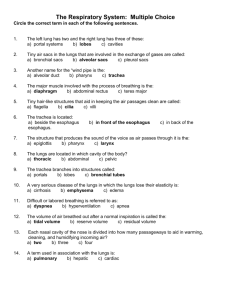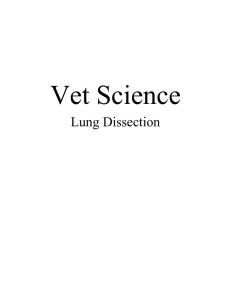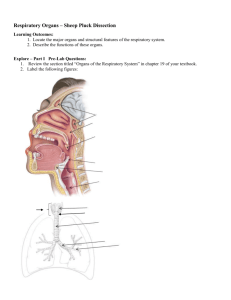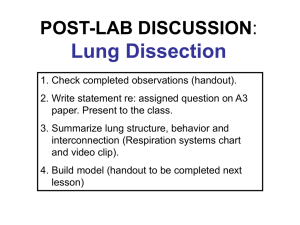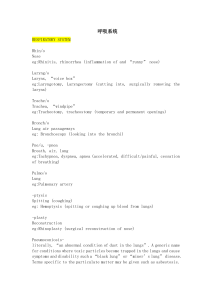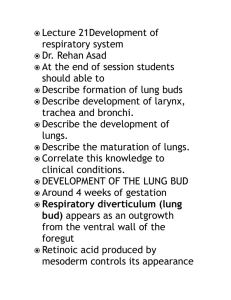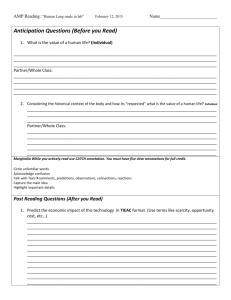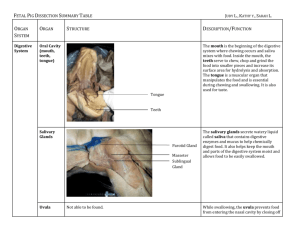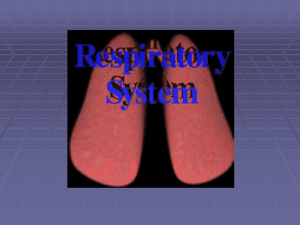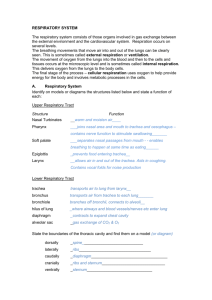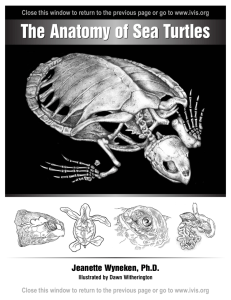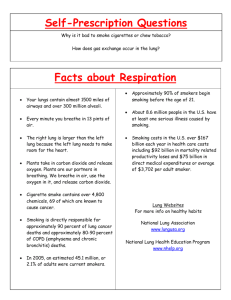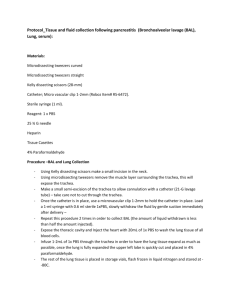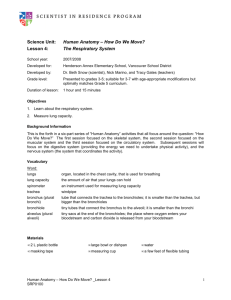Chapter 20
advertisement
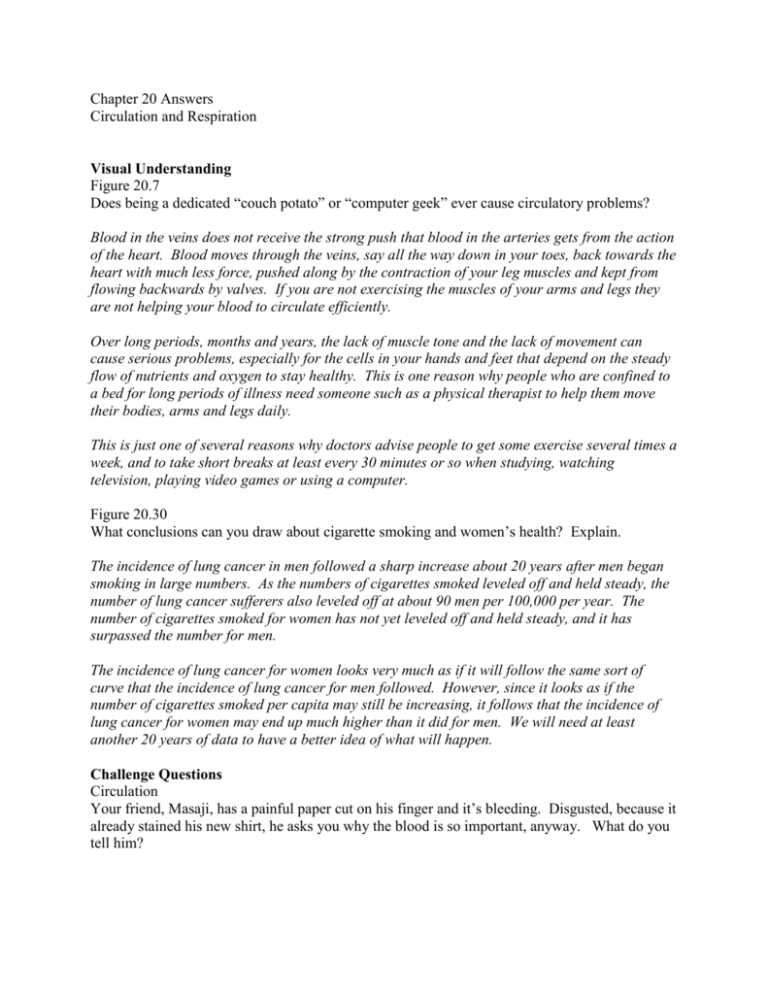
Chapter 20 Answers Circulation and Respiration Visual Understanding Figure 20.7 Does being a dedicated “couch potato” or “computer geek” ever cause circulatory problems? Blood in the veins does not receive the strong push that blood in the arteries gets from the action of the heart. Blood moves through the veins, say all the way down in your toes, back towards the heart with much less force, pushed along by the contraction of your leg muscles and kept from flowing backwards by valves. If you are not exercising the muscles of your arms and legs they are not helping your blood to circulate efficiently. Over long periods, months and years, the lack of muscle tone and the lack of movement can cause serious problems, especially for the cells in your hands and feet that depend on the steady flow of nutrients and oxygen to stay healthy. This is one reason why people who are confined to a bed for long periods of illness need someone such as a physical therapist to help them move their bodies, arms and legs daily. This is just one of several reasons why doctors advise people to get some exercise several times a week, and to take short breaks at least every 30 minutes or so when studying, watching television, playing video games or using a computer. Figure 20.30 What conclusions can you draw about cigarette smoking and women’s health? Explain. The incidence of lung cancer in men followed a sharp increase about 20 years after men began smoking in large numbers. As the numbers of cigarettes smoked leveled off and held steady, the number of lung cancer sufferers also leveled off at about 90 men per 100,000 per year. The number of cigarettes smoked for women has not yet leveled off and held steady, and it has surpassed the number for men. The incidence of lung cancer for women looks very much as if it will follow the same sort of curve that the incidence of lung cancer for men followed. However, since it looks as if the number of cigarettes smoked per capita may still be increasing, it follows that the incidence of lung cancer for women may end up much higher than it did for men. We will need at least another 20 years of data to have a better idea of what will happen. Challenge Questions Circulation Your friend, Masaji, has a painful paper cut on his finger and it’s bleeding. Disgusted, because it already stained his new shirt, he asks you why the blood is so important, anyway. What do you tell him? You explain that the bloodstream has three major functions, transportation, regulation, and protection. Your blood carries oxygen and nutrients to all your cells, and picks up all sorts of wastes to be removed from the body. Where your blood is directed, and which capillaries are closed off or opened, helps you regulate body temperature and perform other functions. Because the blood also carries hormones, your body’s messenger system, it also helps you control a wide variety of other functions. Your blood also helps you defend against many kinds of invaders. Offer Masaji some sympathy and a bandage. Evolution of Vertebrate Circulatory Systems Explain how the mnemonic “VAVA Lungs, VAVA Body” describes the path of the blood in humans. V = Vena cava, the large veins leading from the body into the A = right Atrium which leads to the V = right Ventricle. When the ventricle contracts, it sends the blood into the A = pulmonary Artery and into the Lungs where the blood becomes oxygenated. The blood then returns to the heart through the V = pulmonary Veins which empty into the A = left Atrium which leads to the V = left Ventricle. When the ventricle contracts, it sends the blood into the A = Aorta which carries the blood out and into the Body Respiration Sometimes when people are eating, they take a bite that is too big, or is not completely chewed, and when they swallow it becomes stuck partway down the esophagus. Because the esophagus is a soft, muscular tube that lies just behind the trachea, a somewhat stiffer tube, this bulge of food in the esophagus can sometimes push hard enough on the trachea to close it off. In this case, people have been trained to do the Heimlich maneuver, which is a method of pushing up rapidly on the diaphragm, compressing the lungs. Why might this help? If you push up rapidly on the diaphragm and compress the lungs, the air that was in the lungs must go someplace. Its only choice is to push up through the trachea and try to escape through the mouth and nose. Since the trachea is being pinched closed by the food in the esophagus, the strong blast of air coming up the trachea from the lungs can sometimes bump into the stuck place with enough force to shove the food back into the throat and out the mouth. It often takes several tries, but the food will fly out of the mouth with considerable force, just like a bb from an air gun or a wad of paper from a straw. Lung Cancer and Smoking Why can cigarette smoking be linked to an increased incidence of many kinds of cancer? The p53 protein constantly patrols the DNA in your cells looking for damage. If it finds a problem it sets in motion events to either repair the DNA or kill the cell to prevent mutations, such as those that cause cancer, from reproducing. There are chemicals in cigarette smoke that attach to the gene that controls the manufacture of the p53 protein, keeping it from being made. So the cigarette smoke keeps p53 protein from being made, the p53 protein is not available in the cell to check on the DNA, and if any of the mutations that cause any of the different types of cancer occur, there is no way to stop it.
